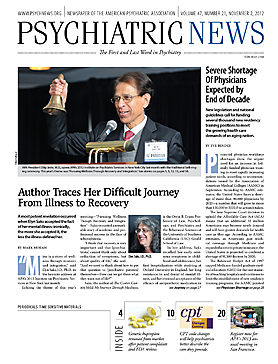Recovery—isn’t that something that takes lots of time to bring to reality for a patient?
Not when it happens in the emergency department (ED), Anthony Ng, M.D., said last month at APA’s Institute on Psychiatric Services in New York.
“The ED is the gateway to care,” said Ng, chief medical officer of Acadia Hospital and chief of the psychiatry service at Eastern Maine Medical Center in Bangor, Maine. “This is where they’ll get their first impression of psychiatry, so even if they’re not ready to accept treatment, we can prepare them for that moment.”
Traditionally, ED psychiatry worked on a “triage-and-refer” model. Now an alternative approach (at least for some patients) involves receiving the first stages of treatment there, although not without some adjustments.
For instance, the practical concerns of operating an ED—urgency, safety, and throughput—create an ethos at odds with the usual paradigm of psychiatric care, said Ng.
“You have to do recovery work in minutes or hours versus days or months,” he said. But there can be a payoff if that effort reduces use of restraints or leads to fewer readmissions and return trips.
Psychoeducation, case management, and even a little cognitive-behavioral therapy can all happen in the ED, said Ng. “These are possible with many patients, but not all.”
Engaging patients long enough to figure out what they really want when they approach the hospital may reveal that alternatives like day hospitals, crisis teams, or even phone calls may meet their needs and cut unnecessary usage. That can open up beds needed for other patients in the ED.
“Needing a medication refill is not a crisis,” said Ng. “We try creating a ‘crisis card’ for each patient, giving him or her a list of alternatives to the ED. We also try to involve families and the patient’s other medical professionals in treatment planning. There is a dynamic relationship, in flux all the time, between partnership and paternalism” that needs adjustment with each patient and at different times.
Making a decision to hospitalize or discharge patients after an examination in the ED is a careful balancing act that benefits from experience in the emergency setting, said Jon Berlin, M.D., recently retired as director of the psychiatric emergency services in Milwaukee.
“We can help long-term practitioners with cases when their patients are in crisis,” said Berlin. “We put much weight on their point of view if they request that a patient be hospitalized, and we can also serve to consult them about risk tolerance.”
In fact, emergency-service psychiatrists have very high risk tolerance and are less risk averse than their community psychiatric colleagues, he said. “We’re less likely to hospitalize.”
Treating patients in the hospital can go a long way toward mitigating the risks of coercive care and the damage to the therapeutic alliance, said Berlin. “But not a lot is being done now in the hospital when stays are short and patients are quickly released on medications.”
The ED evaluation should not only weigh risk and protective factors and ways to eliminate risk, but also document the reasoning process behind a decision to admit to the hospital or discharge to other forms of care, he said.
Berlin also discussed how peer support in the ED can help patients and staff. “Peer specialists remind staff on a daily basis of the patient’s point of view,” he said. “They are role models for patients, instilling hope of recovery. Peers are ready to engage the patient right away, even in the waiting room, lessening hostility.”


